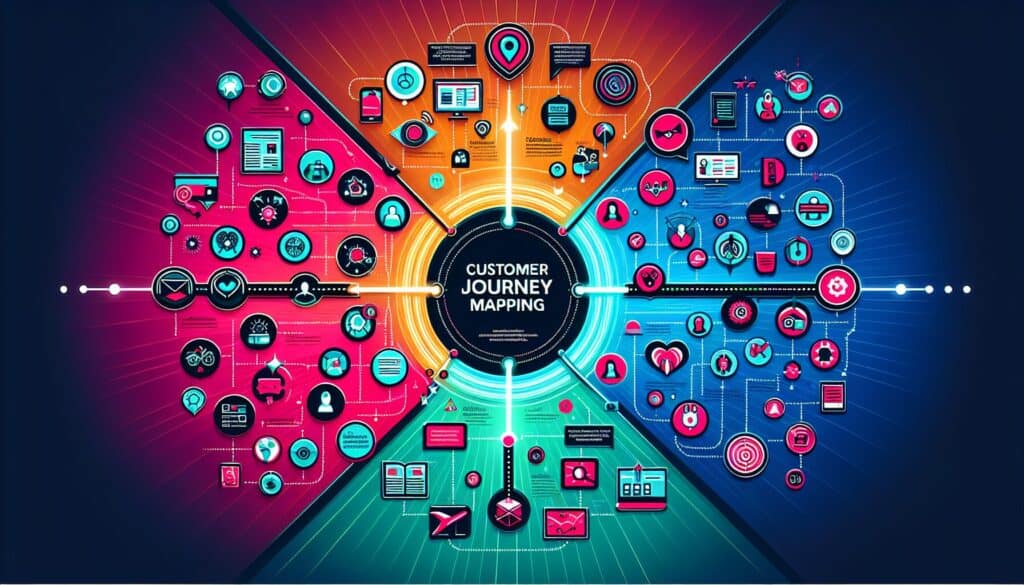A visualization of the end-to-end experience a customer has with an organization or product, across all touchpoints and channels, from their perspective.
- Methodologies: Engineering, Quality
Customer Journey Mapping

Customer Journey Mapping
- Continuous Improvement, Customer Experience, Customer Journey Mapping, Customer Support, CX, Design Thinking, Process Mapping, User experience (UX), User-Centered Design
Objective:
How it’s used:
- Involves researching and outlining the various stages a customer goes through (e.g., awareness, consideration, purchase, post-purchase), their actions, thoughts, emotions, pain points, and opportunities for improvement at each stage. Often presented as a visual map.
Pros
- Provides a holistic understanding of the customer experience; Helps identify pain points and moments of truth; Fosters empathy for customers across the organization; Highlights opportunities for improving customer satisfaction and loyalty.
Cons
- Can be time-consuming to research and create; May oversimplify complex journeys or diverse customer segments if not done well; Requires cross-functional collaboration for accuracy and buy-in; Needs to be updated as customer behaviors and touchpoints evolve.
Categories:
- Customers & Marketing, Ideation, Product Design
Best for:
- Understanding and improving the overall customer experience by visualizing and analyzing all interactions a customer has with a company or product.
Customer Journey Mapping serves a variety of applications across numerous sectors, including e-commerce, healthcare, and technology, playing a significant role in both product development and service design phases. Typically initiated by product managers or user experience designers, this methodology involves collaboration with cross-functional teams, including marketing, customer service, and R&D, to gather comprehensive data on customer interactions. In an e-commerce context, for instance, mapping can reveal obstacles customers encounter during the checkout process, leading to the design of more efficient payment options or clearer communication regarding shipping – both of which can enhance the purchasing experience. In healthcare, understanding the emotional and psychological states of patients can drive improvements in service delivery and communication strategies. Executed effectively, this mapping process not only visualizes customer touchpoints but also serves as a framework for iterative design sessions, allowing teams to prioritize enhancements based on identified pain points. Companies can leverage insights from this analysis to refine their value propositions, foster customer loyalty through improved satisfaction, and ultimately drive business growth through deeper engagements with their clientele. This methodology also reinforces an empathetic corporate culture, as stakeholders across the organization become more attuned to customer needs and behaviors, leading to a more cohesive strategy that aligns all departments toward enriching user experiences.
Key steps of this methodology
- Define specific customer personas.
- Identify and outline distinct stages of the customer experience.
- Map out customer actions within each stage.
- Document customer thoughts and feelings at each stage.
- Identify customer pain points and areas of friction.
- Highlight key interactions and moments of truth.
- Spot opportunities for enhancement in the customer lifecycle.
- Visualize the data in a coherent format for analysis.
- Gather feedback on the map from stakeholders.
- Iterate on the map based on feedback and new insights.
Pro Tips
- Utilize data analytics and customer feedback to identify trends and correlations across different touchpoints, ensuring that the map reflects behaviors grounded in actual usage patterns.
- Involve cross-functional teams throughout the mapping process to gather diverse perspectives, promoting a unified understanding of customer experiences and pain points.
- Regularly revisit and update the map based on new data and evolving customer needs, ensuring relevance and maintaining alignment with organizational objectives.
To read and compare several methodologies, we recommend the
> Extensive Methodologies Repository <
together with the 400+ other methodologies.
Your comments on this methodology or additional info are welcome on the comment section below ↓ , so as any engineering-related ideas or links.
Historical Context
1960
1980
1983
1990
1995
2000
2010
1950
1980
1980
1986
1994
1995
2000
(if date is unknown or not relevant, e.g. "fluid mechanics", a rounded estimation of its notable emergence is provided)














Related Posts
Master Production Schedule (MPS)
Mass Customization
Marketing Funnel
Marketing Audit
MAPO Index (Movement and Assistance of Hospital Patients)
Manufacturing Resource Planning (MRP II)